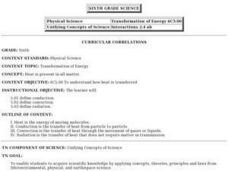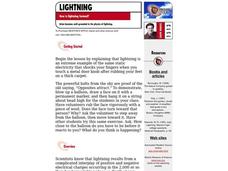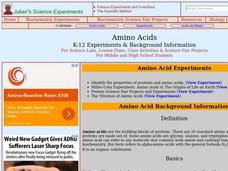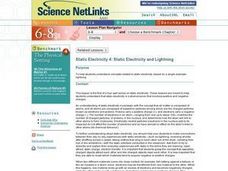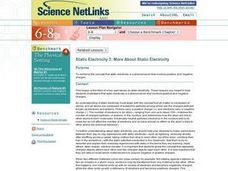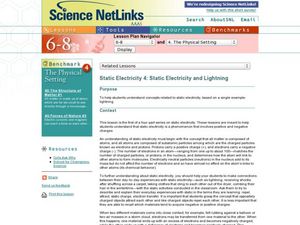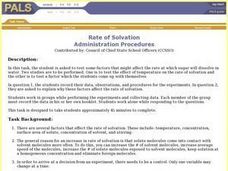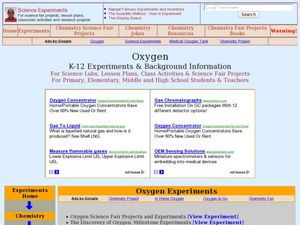Curated OER
Science: What Is the Carbon Cycle?
Students examine the carbon cycle while identifying its sources, sinks, and release agents. Using magazines and newspapers, groups of students design collages illustrating the carbon cycle. Finally, they write responses to several...
Curated OER
Recognizing and Describing Chemical Changes
Seventh graders distinguish between physical and chemical changes in both natural and technological settings. They identify the reactants and products for a given chemical reaction. they then write simple chemical equations given the...
Curated OER
Transformation of Energy: Heat
Sixth graders investigate how heat is transferred and the concepts of conduction, convection, and radiation. They define key vocabulary terms, and observe teacher-led demonstrations of conduction, convection, and radiation.
Curated OER
Snow Science
Students investigate how efficient different substances are at melting snow. Students collect and analysis data.
Curated OER
How is Lightning Formed
Students research lightning paying particular attention to how it is formed, where it is most likely to occur, and how most people struck by lightning survive.
Curated OER
Lightning
Students investigate lightning. In this lightning lesson, students demonstrate how static electricity is in the air by observing how a balloon reacts to a charge.
Curated OER
Amino Acids
Students explore what amino acids are, their history and how they are used in technology. In this protein lesson students identify the properties of proteins and amino acids.
Curated OER
Water and Ice
Students observe water as it changes form. For this water lesson students observe, measure, and describe water as it changes state.
Curated OER
Static Electricity 4: Static Electricity and Lightning
Students explain concepts related to static electricity, based on a single example: lightning.
Curated OER
Static Electricity 3: More About Static Electricity
Students reinforce the concept that static electricity is a phenomenon that involves positive and negative charges.
Curated OER
Electricity
Middle schoolers watch instructor present demonstrations of the basic principles of static electricity, and then conduct some of their own experiments. In small groups, students build simple circuits, using batteries, to try to light up...
Curated OER
Water and Ice
Learners examine water. In this chemistry lesson plan, student examine the physical properties of water and how it changes from a liquid to a solid or a gas. This lesson plan contains links to a second and third complimentary lesson plan...
Curated OER
Amazing Water Changes
Pupils explore the properties of water and how it changes states. In this kindergarten to 2nd grade science instructional activity, students pair a hands-on science activity with two suggested books. This inquiry...
Curated OER
Rate of Solvation
High schoolers test factors that may affect the rate at which sugar dissolve in water. They conduct two studies: One is to test the effect of temperature on the rate of solvation and the other is to test a factor which Students come up...
Curated OER
The Water Cycle/States of Matter
Students engage in a lesson that is concerned with the water cycle and different states of matter. They conduct research using a variety of resources in preparation for taking a quiz. Then students take the quiz in correlation to having...
Curated OER
Solids, Liquids, and Gases
First graders explore the properties of matter. In this states of matter lesson plan, 1st graders conduct scientific investigations that require them to mix, cool, and heat objects in order to observe changes in the properties of matter.
Curated OER
Can You Get A Charge Out Of Matter?
Students observe and demonstrate how objects can be charged positively and negatively and how static electricity works. They observe a teacher-led demonstration, and in small groups rotate through various static electricity activities,...
Curated OER
DNA
Students explore the basics of DNA and its history. In this DNA lesson plan students extract DNA from fruits and understand how it is used in forensics.
Curated OER
Oxygen
Students explore oxygen and its physical and chemical propeties. In this investigative activity students complete several experiments using oxygen.
Curated OER
How Are The Properties of Covalent Compounds Influenced By Chemical Bonding?
Students work together to observe the bond lengths of single, double and triple bonds. They make their own predictions about the strength of the bonds and chemical reactions. They answer discussion questions to complete the...
Curated OER
Nanofibers on Your Clothes
Learners relate the presence of nanofibers in clothing to its ability to repel stains. They observe and contrast the characteristics of nanofiber, Scotchguard treated, and regular fabric then test the stain resistance of each fabric...
Curated OER
A Model of a Scanning Tunneling Microscope
Ninth graders explain how a scanning tunneling microscope works. In this chemistry instructional activity, 9th graders construct atomic models and simulate how their images appear under the STM. They discuss the limitations of their...
Curated OER
Structural Changes in a Protein
Young scholars observe and manipulate the structure of a protein. They form an alpha helix, a beta sheet, and add disulfide bonds. They create a multimeric protein and compare their location with other students.
Curated OER
"Why Is the Sky Blue?"
Middle schoolers investigate why the sky is blue and the sunset is red. They are asked why do you think that we see the sky as blue? Students write a hypothesis on their "Blue Sky Lab Sheet". They explain why they think that the sky...
Other popular searches
- Gumdrop Atoms and Molecules
- Counting Atoms Molecules
- Making Atoms and Molecules
- Atoms & Molecules Ppt
- Matter Atoms Molecules
- Science, Atoms and Molecules
- Science Atoms and Molecules
- Atoms Molecules Elements
- Atoms & Molecules Pot
- Atoms and Molecules Lesson
- Atoms Molecules Units
- Atoms and Molecules Musical


